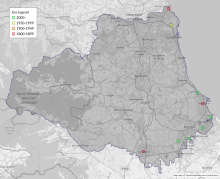Brown-tail
Euproctis chrysorrhoea

Species account (old)
The only good records of this species were in 1875 when Eales took two at South Shields and Robson collected about a dozen specimens from palings on the railway side at Hartlepool. None were ever seen again, suggesting a chance immigration.
Statistics
| Records | 10 |
|---|---|
| Individuals | 22 |
| Largest Sample | 12 |
| First Recorded | 1849 |
| Last Recorded | 2022 |
| Earliest Adult Record | 29/06 |
| Latest Adult Record | 28/08 |
| Monad Coverage | 0.3% |
| Hexad Coverage | 14.3% |

Map
This map shows all records of Brown-tail - Euproctis chrysorrhoea in the Durham (VC66) database per monad (1km grid square). The map can be explored further by zooming and panning, can be reset using the button on the left, and can be filtered by selecting the era. Click on a monad to view a full list of species recorded in it, or its containing hexad (10km grid square).

Week graph
This graph shows the County Durham (VC66) records of Brown-tail - Euproctis chrysorrhoea per 7-day period, differentiated by life stage. Hover over/tap the graph to see an exact count of records at that point in time. Hover over/hold the life stage legend to highlight a particular life stage; click on a life stage label to remove it from the graph. The graph can be filtered further by selecting the era.
The graphs below show the total records and individuals of Brown-tail - Euproctis chrysorrhoea in County Durham (VC66) per time period. Hover over/tap the graph to see an exact number of records and individuals at a particular point in time. Hover over/hold a label to highlight a particular metric; click on a metric label to remove it from the graph.
Era graph
Year graph

Gallery
There are no photos of Brown-tail - Euproctis chrysorrhoea on the website. If you would like to contribute any photographs please email admin@durhammoths.org.

Foodplants
This is a list of foodplants known to be used by the larval stages of Brown-tail - Euproctis chrysorrhoea in the UK.
Habitats
This is a list of habitats that Brown-tail - Euproctis chrysorrhoea is known to occur in within the UK.
Habitat and foodplant information derived from Cook, P.M.; Tordoff, G.M.; Davis, A.M.; Parsons, M.S.; Dennis, E.B.; Fox, R.; Botham, M.S.; Bourn, N.A.D. (2022). Traits data for the butterflies and macro-moths of Great Britain and Ireland, 2022. NERC EDS Environmental Information Data Centre. https://doi.org/10.5285/33a66d6a-dd9b-4a19-9026-cf1ffb969cdb
